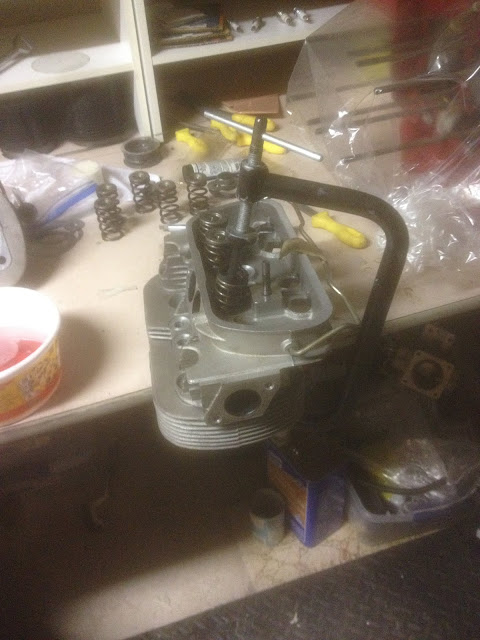I walnut blasted my heads a few months ago, and I didn't oil the valve seats well enough to keep them from corroding a little. Nothing major, but enough that I needed to do more than lap the valves in. What follows is a good example of wasted time, wasted money, and a whole lot of frustration. In short, if you're looking to do valve seat work, skip the next two miserable paragraphs.
I looked into getting a valve seat grinding setup, and wow, are they pricey! So I found a site that sells just the stones for about $14 bucks apiece and set about making my own self-centering stone holder. I cut the head off of an old exhaust valve to use as a pilot, drilled a hole in a chunk of aluminum, which I then heated up with a propane torch and dropped the aluminum onto the exhaust valve/pilot. After it cooled, I used a collet to hold the assembly in the lathe and turned threads on the aluminum portion to match the grinding stones I'd purchased. I then took the 45° stone for the intake seat, screwed it onto my new tool, and placed the tool back in the collet, set up my top slide to the right angle, and used a diamond-tipped dressing tool to grind the stone perfectly concentric. I wanted to make sure I didn't impart any weird tilt to the tool while I was using my drill to spin it, so I pushed a piece of 1/4" fuel line over the end of the tool and connected the other end to the drill. This seemed to work ok, except that the rubber hose allowed the tool to vibrate and caused some chatter unless I was careful not to apply very much pressure.
I worked through all three stones, re-angling them with a diamond stone on the lathe between valve seats to make sure the angle stayed true. Once I got to the 45s, I started checking the seat width. It wasn't until then that I realized I was grinding non-concentric valves. Whoops. I took a break to do some research, and came across a company called Neway. It took me some time to build up the nerve to pay for the tooling needed, but in the end I caved and picked up the stuff. After cutting a couple of the seats, I can say with confidence that was the right decision. Here's a picture of a valve seat that's had the 15 and 75 degree angles cut in it with their cutters.

It's a little tough to see, but the red line is what hasn't yet been touched. At its thickest, it's about .053, and at it's thinnest, it's around .018. That's pretty bad! The good news is, with the Neway system, I've been able to recut the seats concentric with the valve guides, and I'll be moving on to CCing the heads shortly.
This is what all of my valve seats look like now:
That's an exhaust valve seat, so the width is about .01" wider than the intake seats. They all look a lot more concentric now, though, so it's time to put new Dykem on the valves and seats and try to fit them together. I wanted to check for even contact between all the valves and seats, but I didn't want to remove any material. I decided to use toothpaste instead of lapping compound, because it's still abrasive enough to remove the Dykem but not enough to carve material away from the seats.
With all the valves and seats marked up, I put toothpaste around the contact area of the valves, placed them in their respective guides, applied a little pressure and rotated them 90 degrees back and forth a few times. I was really impressed; every single one of my seats showed clean, even lines around the entire 45 degree face, and every single one of my valves showed even contact around the mating surface. Consider me sold - Neway cutters are the way to go!
The last thing I did was clean up the toothpaste as best as I could and hose down the valves and seats with WD-40. Tomorrow I'll bring the heads to work and clean them up again in the parts washer, and then I can assemble the valves and springs into the heads for good.









































